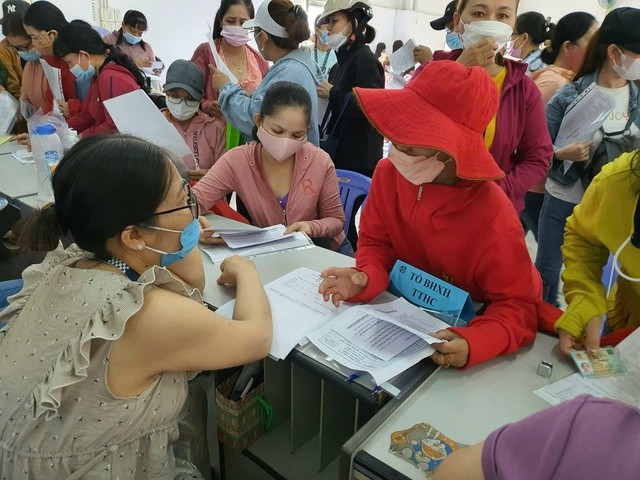According to the report "World Employment and Social Outlook: Trends 2025" by the International Labor Organization (ILO), the global labor market is maintaining stability but still faces many challenges in the recovery process.
The global unemployment rate in 2024 will remain at 5%, the same as in 2023. However, this stability does not mean that the labor market has improved significantly, because the number of jobs created is not enough to meet the needs of the growing labor force.

In particular, young people continue to be the most affected group with an unemployment rate of up to 12.6%, much higher than other labor groups.
In addition to the 186 million unemployed, there are 137 million potential workers who are ready to work but have not yet found suitable opportunities. In addition, 79 million workers who want to work but are constrained by other obligations such as family care indicate that work-life balance remains a major barrier for many.
While the overall labor market has remained relatively stable, the global labor force participation rate has been on a slight downward trend. This trend is more pronounced in low-income countries, where economic conditions are uncertain and quality job opportunities are limited.
In advanced economies, participation rates for older adults and women are rising, reflecting efforts to promote gender equality and tap into the pool of experienced workers to cope with population aging. However, gender gaps in the labor market remain significant, with women working at lower rates than men.

The disparity between developed and less developed regions continues to be a significant issue. Some 240 million workers, or 7% of the global workforce, are in employment but still living in poverty due to low incomes. This is particularly true in low-income countries where real wage growth has not been sufficient to offset the impact of the COVID-19 pandemic and persistent inflation.
Furthermore, more than 50% of the global workforce lacks adequate social protection, making them vulnerable to economic and social shocks. Worryingly, the proportion of young people not in employment, education or training (NEET) has risen by nearly 4% in low-income countries, suggesting that many young workers are struggling to enter the labour market and are at risk of being left out of the economy.
Meanwhile, global labor productivity is slowing, with growth down 0.5% from the pre-pandemic average. In particular, industries in manufacturing powerhouses are under heavy pressure from high energy prices, rising production costs and weak consumer demand.

The development of technology, especially artificial intelligence (AI) and automation, is bringing about major changes in the labor market.
While AI can improve efficiency and optimize production processes, it also increases the risk of job losses in some traditional industries, especially those that are repetitive and can be replaced by machines. On the other hand, the expansion of clean energy infrastructure, such as charging stations and smart grids, is boosting demand for workers in related fields, opening up many new job opportunities.
The global economic outlook is also not very optimistic, with GDP growth forecast to reach around 3.2% in 2025, continuing a downward trend compared to previous years. Inflation may decline but has not returned to target levels in many developed countries, affecting purchasing power and investment. Fiscal and monetary policies in many countries are gradually returning to pre-pandemic levels, but this may slow down the economic recovery, especially in low- and middle-income countries.
In this context, the ILO emphasizes that, in order to achieve the 2030 sustainable development goals, countries need to focus on improving labor productivity, improving the quality of employment and ensuring decent working conditions. In particular, low-income countries need to take advantage of remittance flows and attract private investment to promote local economic growth, narrow the development gap and create opportunities for workers to have more stable and sustainable jobs.
Source: https://baolaocai.vn/ti-le-that-nghiep-o-thanh-nien-cao-thach-thuc-lon-cho-thi-truong-lao-dong-toan-cau-post399303.html




![[Photo] Vietnam shines at Paris International Fair 2025 with cultural and culinary colors](https://vstatic.vietnam.vn/vietnam/resource/IMAGE/2025/5/4/74b16c2a197a42eb97597414009d4eb8)
![[Photo] General Secretary To Lam receives Sri Lankan President Anura Kumara Dissanayaka](https://vstatic.vietnam.vn/vietnam/resource/IMAGE/2025/5/4/75feee4ea0c14825819a8b7ad25518d8)
![[Photo] Bus station begins to get crowded welcoming people returning to the capital after 5 days of holiday](https://vstatic.vietnam.vn/vietnam/resource/IMAGE/2025/5/4/c3b37b336a0a450a983a0b09188c2fe6)













































































![[Video]. Building OCOP products based on local strengths](https://vstatic.vietnam.vn/vietnam/resource/IMAGE/2025/5/3/61677e8b3a364110b271e7b15ed91b3f)




Comment (0)